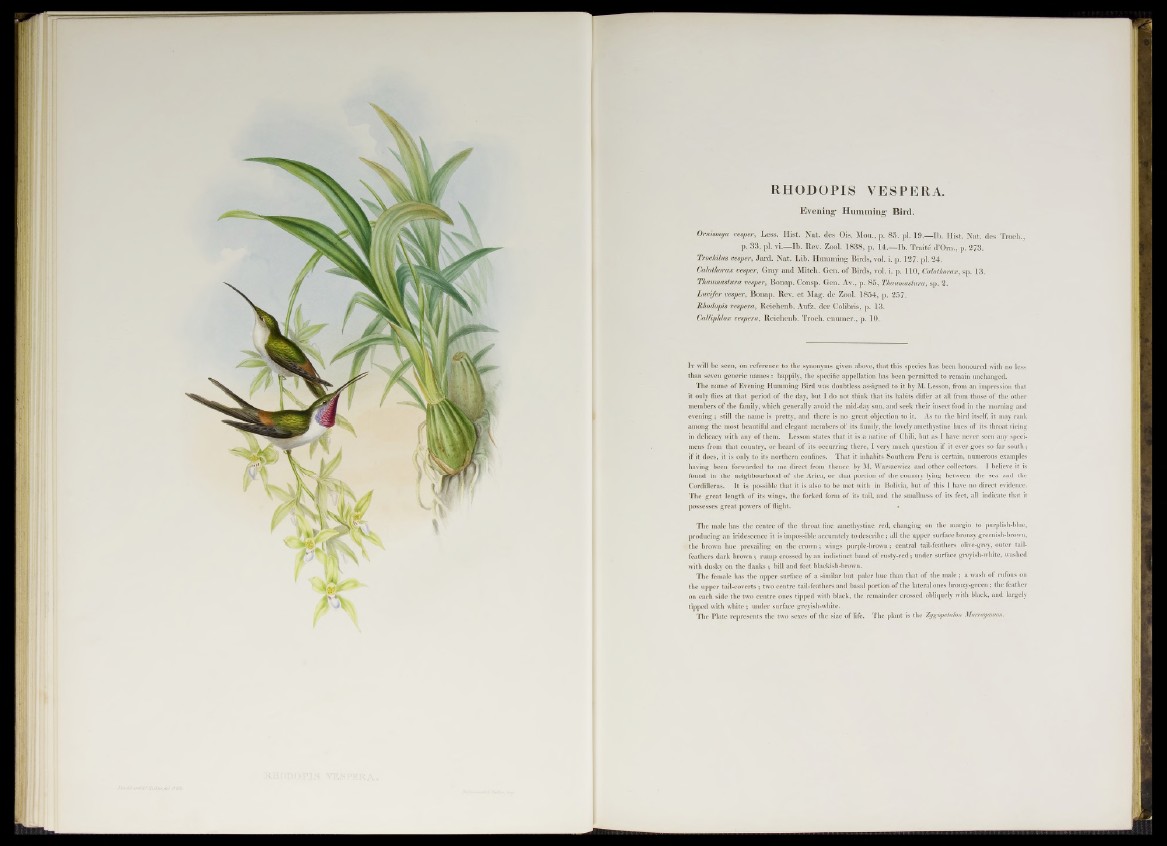
RHODOPIS VESPERA.
Evening* Humming Bird.
Ornismya vesper, Less. Hist. Nat. des Ois. Mou., p. 85. pl. 19.—lb. Hist. Nat. des Troch.,
p. 33. pi. vi.— Ib. Rev. Zool. 1838, p. 14.— lb. Traité d’Om., p. 273.
Trochilus vesper, Jard. Nat. Lib. Humming Birds, vol. i. p. 127. pi. 24.
Calothorax vesper, Gray and Mitch. Gen. o f Birds, vol. i. p. 110, Calothorax, sp. 13.
Thaumastura vesper, Bonap. Consp. Gen. Av., p. 85, Thaumastura, sp. 2.
Lucifer vesper, Bonap. Rev. et Mag. de Zool. 1854, p. 257.
BJwdopis vesper a, Reichenb. Aufz. der Colibris, p. 13.
Calliphlox vespera, Reichenb. Troch. enuiner., p. 10.
It will be seen, on reference to the synonyms given above, that this species has been honoured with no less
than seven gener ic names : happily, the specific appellation has been permitted to remain unchanged.
The name of Evening Humming Bird was doubtless assigned to it by M. Lesson, from an impression that
it only flies at that period of the day, but I do not think that its habits differ at all from those of the other
members of the family, which generally avoid the mid-day sun, and seek their insect food in the morning and
evening ; still the name is pretty, and there is no great objection to it. As to the bird itself, it may rank
among the most beautiful and elegant members of its family, the lovely amethystine hues of its throat vieing
in delicacy with any of them. Lesson states that it is a native of Chili, but as I have never seen any specimens
from that country, or heard of its occurring there, I very much question if it ever goes so far south;
if it does, it is only to its northern confines. That it inhabits Southern Peru is certain, numerous examples
having been forwarded to me direct from thence by M. Warszewicz and other collectors. I believe i t is
found in the neighbourhood of the Arica, or that portion of the country lying between the sea and the
Cordilleras. It is possible that it is also to be met with in Bolivia, but of this I have no direct evidence.
The great length of its wings, the forked form of its tail, and the smallness of its feet, all indicate that it
possesses great powers of flight.
The male has the centre of the throat fine amethystine red, changing on the margin to purplish-blue,
producing an iridescence it is impossible accurately to describe; all the upper surface bronzy greenish-brown,
the brown hue prevailing on the crown; wings purple-brown; central tail-feathers olive-grey, outer tail-
feathers dark brown; rump crossed by an indistinct band of rusty-red; under surface greyish-white, washed
with dusky on the flanks ; hill and feet blackish-brown.
The female has the upper surface of a similar but paler hue than that of the male; a wash of rufous on
the upper tail-coverts; two centre tail-feathers and basal portion of the lateral ones bronzy-green; the feather
on each side the two centre ones tipped with black, the remainder crossed obliquely with black, and largely
tipped with white ; under surface greyish-white.
The Plate represents the two sexes of the size of life. The plant is the Zygopetalon Murrayanum.